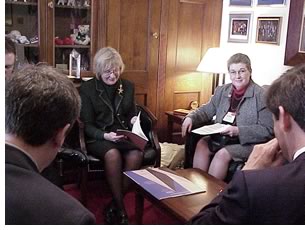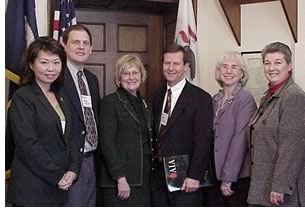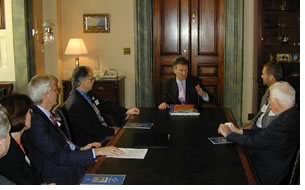

Advocacy: We Are the Message
Presidents, presidents-elect, and executives from the AIA local, state, and national components devoted the first full day of the 2004 Grassroots conference to federal government advocacy. Preparing in the morning with inspirational messages from political pollster Frank Luntz, PhD, and Environmental Protection Agency Administrator Mike Leavitt, AIA leaders headed to Capitol Hill for an afternoon of visits with their senators and representatives. Among the highlights of the day, the AIA national leadership joined the South Dakota delegation as they visited with Senate Minority Leader Tom Daschle in his private offices.
“Over the years, many Grassroots veterans have come to know Thursday as ‘Government Affairs Day,’” said AIA President Eugene C. Hopkins, FAIA, as he kicked off Thursday morning’s plenary session. “But by putting the emphasis on ‘advocacy,’ as we are doing today, we’re making a subtle, yet important distinction . . . By calling today ‘Advocacy Day,’ the focus is put squarely on where it belongs—meaning us, on you and me.”
AIA members have told Institute leaders that advocacy is one of the fundamental expectations of membership and one of the primary reasons they join the AIA, Hopkins noted. Advocacy, he said, can be accomplished with a strategy that will “open doors, get a place at the table, and persuade others to get behind the issues we believe are important to our profession and the nation as a whole.” Three specific opportunities emerged:
- Community development and livability, including how architects promote policy that not only shapes our neighborhoods and cities, but also make the case for this profession as a vital part of the solution to major social and economic problems, such as public health, accessibility, security, school construction, energy, and transportation
- How architects relate to the government, including government facility design and research
- Issues that affect our bottom line, including tax fairness, regulations, tort reform, qualifications-based selection, and liability issues.
 The
issues
The
issues
AIA Chief Operating Officer Jim Dinegar and AIA Chief Economist Kermit
Baker, PhD, Hon. AIA, helped familiarize Grassroots participants with
the messages they would bring to their legislators on Capitol Hill that
afternoon.
On a day-to-day basis, the national AIA component takes the members’ collective voice to decision makers in Washington. Still, Dinegar said, “there is nothing better than having members make that connection and develop relationships with elected officials.”
To help delegations jump-start their discussions with congressional representatives, Baker’s Economics and Markets Research team compiled an economic report customized for each state that included data on the state’s economy, major industries, employment, the number of architects residing in the state, and the number licensed to practice.
The design and construction industry is one of the largest sectors in the U.S. economy, “accounting for more than 8 percent of the gross domestic product,” Baker said. Construction spending approached $900 billion in 2003, and the AIA’s Work on the Boards survey is “telling us things are looking up in 2004,” Baker said, making design and construction one of the few bright spots in a flagging economy. He noted that the sector has been generating jobs even while manufacturing has been losing them. “Growth in construction generates growth throughout the economy,” he said.
In addition to the economic reports, which offered policymakers new and specialized research on the size of the industry and 5 and 10-year growth rates from McGraw-Hill Construction, AIA members were provided with a briefing on the tax bill and the transportation and highway funding legislation, two pieces of legislation that Dinegar said speak to “our opportunities and values.”
Referring to the likely funding level of the transportation bill, Dinegar said, “$300 billion has a way of shaping communities. Shouldn’t architects be more involved?” Specifically, he said, the AIA is advancing three amendments to enable local leaders to use transportation investment effectively to create better and stronger communities. The three amendments would:
- Add a new “context sensitive design” provision encouraging states to design highway projects that preserve environmental, scenic, or historic values and consider the context of the locality
- Direct the secretary of transportation to arrange for the AIA to conduct a study on the role of transportation in enhancing the quality of life in our communities
- Make federal grants available for projects that follow enhanced design and planning.
“Our timing couldn’t be better,” Dinegar said of the opening to weigh in on legislation that advances new tax incentives for certain business activities as a way to create jobs and boost economic expansion. The House vehicle (H.R. 2896) provides for a 3 percent tax cut on gross receipts for larger (C-corporations) A/E firms. The Senate version (S. 1637) expands this to include firms of all sizes, including sole proprietorships, but does not extend it to architects. Members of the AIA were urged to call for the House to expand its version to all types of firms and the Senate to include architects.
Dinegar’s words on timing were to prove true later in the afternoon. With the tax bill at the forefront of Daschle’s thoughts, the Senate leader told the AIA South Dakota delegation that he would support an effort to include architects in the Senate version.
 Words
of advice
Words
of advice
Following the presentation by Baker and Dinegar, the morning’s proceedings
took a sudden turn—literally—as Luntz was introduced and yet
the stage stood empty. With his voice booming from the back of the room,
the renowned political pollster promised to share phrasing that architects
can use to make their own voice resonate in the U.S. Capitol and with
lawmakers back home. Of course, he based his findings on research. Having
conducted a focus group earlier in the week to gauge the public’s
view of architects, Luntz launched into a spirited give and take.
Architects must differentiate themselves from developers, he said. “You’re not developers, but your community does not know you’re not developers,” a term that tested poorly in his focus group. Instead, he suggested, architects should define themselves as “designers, visionaries, thinkers, and planners.” Architects should be looked to as “caretakers” and “conveners” of community. He recommended that architects should use terminology that is focused on the future, as in the phrase, “people come to us with their dreams and we turn them into reality.”
One of the most important ways architects can advocate for position is by talking about quality-of-life issues and avoiding technical jargon. He said politicians are often concerned about creating a legacy. Who better to help create that legacy than an architect, Luntz asked. With this in mind, he suggested some descriptions architects might use to describe what they do:
- City planners
- Planning on a human scale
- Take the best part of history and preserve it
- Smart strategic planning
- Connecting communities and connecting individuals
- We want to create healthier communities for generations to come
- We can be the answer to changing the quality of life.
Partnerships in action
Next up, newly appointed U.S. Environmental Protection Agency Administrator
Leavitt presented his view of the key environmental issues facing architects
today, including green buildings, energy efficiency, air quality, clean
and safe water, land preservation, and healthy ecosystems and communities.
He lauded the AIA leadership on promoting livable communities and sustainable
buildings and noted that the EPA wants to work with AIA members to achieve
common goals. “Green buildings are clearly in the best interest”
of the American people Leavitt said. “The long-term payback is there.”
He said a memorandum of understanding is in the works to formalize the
relationship between the AIA Committee on the Environment and the EPA.
He indicated his agency would work to collect data to make the case for
green buildings and find ways to integrate them into Smart Growth strategies.
“If we lose this opportunity, we will lose the opportunity of a
generation,” Leavitt said.
Fortified with purpose and equipped with their state-budget descriptions and a beautifully designed legislative calendar illustrated with AIA award-winning projects, Grassroots delegates boarded buses bound for Capitol Hill. Looking for a representative group, AIArchitect followed the AIA Illinois delegation on their appointed visits.
At the same time, the national AIA Executive Committee walked the three blocks to the Treasury Department to meet with Acting Assistant Secretary for Economic Policy Mark J. Warshawsky. Baker presented his AIA Work on the Boards and other research findings to inform Warshawsky on the importance of architects to the national economy. The AIA Economics and Markets Research team has established that their research has a solid correlation to what the general economy will be doing in the next two to three quarters. Duly impressed, the assistant secretary asked for access to the AIA data to use in Treasury’s aggregate forecasting and asked the AIA elected officers in attendance for a synopsis of their regional economic conditions.
 Taking
the Hill
Taking
the Hill
Members of AIA Illinois decided to divide and conquer their Congressional
delegation. AIA Illinois Executive Vice President Mike Waldinger set up
a full slate of appointments, including meetings with representatives
of Senator Richard J. Durbin, the assistant Democratic Floor Leader, and
House Speaker Dennis Hastert (R). Members of the group also talked with
Rep. Judy Biggert (R). Along with the key AIA advocacy issues, the group
discussed with Biggert the tough times they have had in the past year,
some laying off employees, but said that they were more optimistic for
2004. They said funding for context-sensitive design programs could “improve
the quality of life” for the residents of her Hinsdale, Ill., district.
“I know it’s not easy, and I know it’s not fun, but I’m really glad you guys are doing this,” Hastert Legislative Assistant Dena Morris, told Walter Hainsfurther, AIA, and the other Illinois architects she met in the cafeteria of the Dirksen Senate Office Building. “It’s really important and helpful.” Hainsfurther stressed the importance of design quality in new public projects and the valuable consequences of implementing a fair tax for the wide range of architects and engineers. “These are good things for us to be focused on and aware of,” Morris said. “Don’t let the senator forget about you!”
 Meanwhile,
back in Daschle’s office, AIA South Dakota Executive Director Ward
Whitwam, FAIA; President Thomas Baffuto, AIA; and President-elect Gerald
E. Lindberg, AIA, were joined by AIA President Hopkins; First Vice President
Douglas L Steidl, FAIA; Dinegar; and Baker. Hopkins impressed on the senator
the pressing need of preserving the architectural heritage of the nation’s
communities, a note that resonated with Daschle as he recalled a beautification
project in Sioux Falls. On hearing that the AIA is working with Rep. Wayne
Gilchrest (R-Md.) on an amendment to the transportation bill now before
the House, Daschle said it sounded good and he would remember the visit
when the House-approved bill goes to conference. “We have to put
some architectural emphasis on redevelopment,” the senator agreed.
Meanwhile,
back in Daschle’s office, AIA South Dakota Executive Director Ward
Whitwam, FAIA; President Thomas Baffuto, AIA; and President-elect Gerald
E. Lindberg, AIA, were joined by AIA President Hopkins; First Vice President
Douglas L Steidl, FAIA; Dinegar; and Baker. Hopkins impressed on the senator
the pressing need of preserving the architectural heritage of the nation’s
communities, a note that resonated with Daschle as he recalled a beautification
project in Sioux Falls. On hearing that the AIA is working with Rep. Wayne
Gilchrest (R-Md.) on an amendment to the transportation bill now before
the House, Daschle said it sounded good and he would remember the visit
when the House-approved bill goes to conference. “We have to put
some architectural emphasis on redevelopment,” the senator agreed.
Copyright 2004 The American Institute of Architects.
All rights reserved. Home Page ![]()
![]()
 |
||
| Take a
free eClassroom continuing ed class featuring EPA Adminstrator Leavitt’s
address. Photos by the author.
|
||